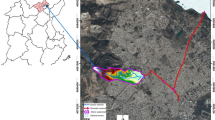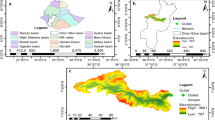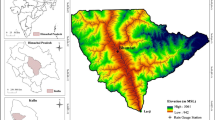Abstract
The Azzaba City located in the North East of Algeria has undergone rapid urbanization during the past few years. Infrastructure development has further enhanced the land use change process in the area. Bad land use management practices are thought to be the cause of increased flooding. While the characteristics of the precipitation are tied to the climatology of the region, and can change only over the long term, the urbanization, an antropic factor, changes more rapidly and plays a non negligible role in modifying the land use. It is thus very important to assess the runoff changes due to land-use changes. Moreover, the knowledge of the rainfall runoff relationship is an essential tool in modelling and design of urban drainage networks. In this paper two hydrological models, namely WBNM and HEC-HMS, and a GIS procedure are used to predict runoff hydrographs of a small urban catchment located in Azzaba city. The aim was to test the effect of catchment size and time steps on runoff hydrograph shape, and to evaluate the catchment reaction to a given rainfall event obtained from the established IDF Curves. Furthermore a sensitivity analysis of the parameters of the models is carried out. In addition the results of the models are compared with the observed runoff data, measured during a storm event that occurred in 11th of Mars, 2014. This calibration is performed by applying different situations of catchment size and time steps. Then, characteristics of calculated hydrographs were compared with the same characteristics of the same observed hydrographs and analyzed statistically. The results indicate that HEC-HMS provide acceptable simulations in the flood events, which WBNM fail to simulate. Finally, hydrographs simulated by the HEC-HMS model have the best fit with the real situation. It is necessary to generalize this study and build up the data base for the further application of rainfall runoff model in Algeria.






Similar content being viewed by others
References
Ahmad M, Ghumman R, Ahmad S (2009) Estimation of Clark’s instantaneous unit hydrograph parameters and development of direct surface runoff hydrograph. J Water Resour Manag 23:2417–2435. doi:10.1007/s11269-008-9388-8
Alcamo J, Flörke M, Märker M (2007) Future long-term changes in global water resources driven by socio-economic and climatic changes. Hydrol Sci J 52(2):247–275
Askew AJ (1968). Lag Time of Natural catchments, University of NSW. Water Research Laboratory Report. No. 107
Askew AJ (1970) Derivation of formulae for variable lag time. J Hydrol 10(3):225–242
Boyd MJ, Rigby EH, Van Drie R, Schymitzek L (2007). Watershed Bounded Network Model user manual. University of Wollongong
Castronova MA, Goodall JL (2013) Simulating watersheds using loosely integrated model components: evaluation of computational scaling using open MI. Environ Model Softw 39:304–313
Costa MH, Foley JA (1999) Trends in the hydrologic cycle of the amazon basin. J Geophys Res 104(D12):14189–14198
DeFries RS et al (2010) Deforestation driven by urban population growth and agricultural trade in the twenty-first century. Nat Geosci 3:178–181
Feldman AD (2000) “HEC-HMS Technical Reference Manual” CPD-74B U.S. Army Corps of Engineers. March
Groisman PY et al (2004) Contemporary changes of the hydrological cycle over the contiguous United States: trends derived from in situ observations. J Hydrometeorol 5:64–85
James, L.D. and S.J. Burges, 1982. Se lection, calibration and testing of hydrologic models. Hydrologic modeling of small watersheds, C.T. Hann, H.P. Johnson, and D.L. Brakensiek (Editors). ASAE Monograph, St. Joseph, Michigan, pp. 437–472.
Kati L, Indrajeet C (2005) Sensitivity analysis, calibration and validation for a multisite and multivariable SWAT model. J Am Water Res Ass 41(5):1077–1089
Leimer S, Pohlert T, Pfahl S, Wilcke W (2011) Towards a new generation of high-resolution meteorological input data for small scale hydrological modeling. J Hydrol 402(3–4):317–332
Molini A, Katul GG, Porporato A (2011) Maximum discharge from snowmelt in a changing climate. Geophys Res Lett 38, L05402
Nash JE, Sutcliffe JV (1970) River flow forecasting through conceptual model. Part 1: a discussion of principles. J Hydrol 10:282–290
Seager R et al (2007) Model projections of an imminent transition to a more arid climate in southwestern North America. Science 316:1181–1184
Sivapalan M, Takeuchi K, Franks SW, Gupta VK, Karambiri H, Lakshmi V, Liang X, McDonnell JJ, Mendiondo EM, O’Connell PE, Oki T, Pomeroy JW, Schertzer D, Uhlenbrook S, Zehe E (2003) IAHS decade on predictions in Ungauged Basins (PUB), 2003–2012: Shaping an exciting future for the hydrological sciences. Hydrol Sci J J Des Sciences Hydrol 48:857–880
USDA Soil Conservation Service (1986), Urban hydrology for small watersheds. Technical Release 55, U.S. Department of Agriculture, Washington, DC
USACE-HEC, 2010, “Hydrologic Modeling System, HEC-HMS v3.5. User’s Manual”, US Army Corps of Engineers, Hydrologic Engineering Center, August 2010
Veneziano D, Villani P (1999) “Best linear unbiased design hyetograph”. Water Resour Res 35(9):p2725
Ye B, Yang D, Kane DL (2003) Changes in Lena river streamflow hydrology: human impacts versus natural variations. Water Resour Res 39(7):1200
Author information
Authors and Affiliations
Corresponding author
Rights and permissions
About this article
Cite this article
Laouacheria, F., Mansouri, R. Comparison of WBNM and HEC-HMS for Runoff Hydrograph Prediction in a Small Urban Catchment. Water Resour Manage 29, 2485–2501 (2015). https://doi.org/10.1007/s11269-015-0953-7
Received:
Accepted:
Published:
Issue Date:
DOI: https://doi.org/10.1007/s11269-015-0953-7




